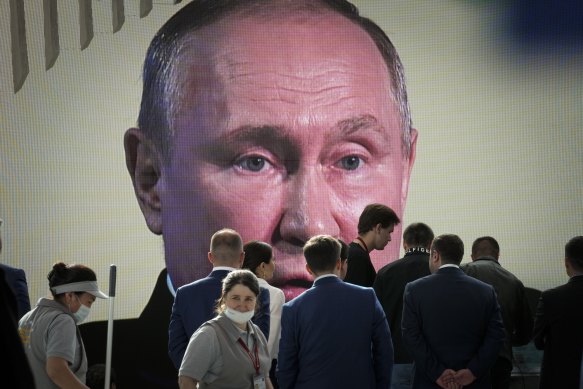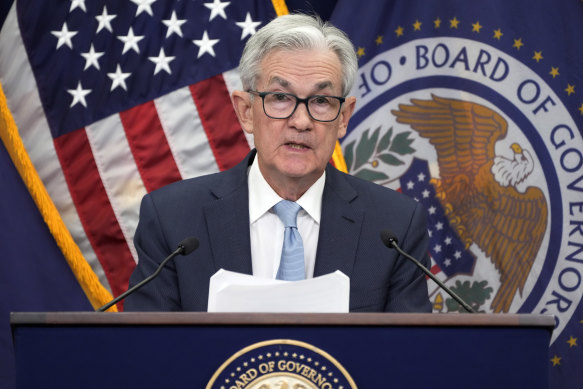It wouldn’t take much to derail the global economic recovery

A slew of economic data and a cautiously optimistic upgrading of the global economic outlook by the International Monetary Fund tend to support the argument that this year will see the bottoming out of the global economy.
That’s not to say that there aren’t continuing risks and uncertainties – the IMF says that “the balance of risks remained tilted to the downside – but that the gloominess that was pervasive for much of last year now has a tinge of cautious optimism.
China’s economic rebound is picking up pace, but it could quickly fall apart. Credit:Bloomberg
Central to the view that the global economy is stabilising and improving is China’s release from the shackles of its “zero COVID” policies, with early signs of a sharp rebound in activity that will also drive growth in the wider Asian region.
Perhaps more surprising is that it appears the eurozone might narrowly avoid what appeared last year to be the inevitability of a recession, as the war in Ukraine and the energy crisis it ignited in Europe combined with raging inflation and a central bank committed to stamping it out by aggressively raising interest rates to choke activity.
While the IMF does forecast a fall in global growth, from 3.4 per cent last year to 2.9 per cent, that’s 0.2 percentage points higher than it was predicting in its previous quarterly update in October. After that relatively modest dip, the IMF then sees growth rebounding to 3.1 per cent next year.
That scenario, along with a peaking of inflation rates, is why it describes this year as a “turning point” for the global economy. Global inflation is forecast to fall from last year’s 8.8 per cent to 6.6 per cent this year and 4.3 per cent in 2024.
There are obvious risks to the reasonably benign outlook depicted by the IMF.
China, where COVID is now rampant, could stall if its health system isn’t able to cope, with spillover effects for the rest of the world because of the significance of its industrial base and its role in global supply chains.
Its property crisis remains unresolved and remains a ticking time bomb for its economy and financial system.
Consumers, who China’s economic agencies are relying on to power the economic rebound, might not embrace the end of the zero COVID years and continue to sit on the savings they have stockpiled though the pandemic, although the early travel and spending data is promising.
The war in Ukraine remains a wildcard for the global economy.Credit:AP
The war in Ukraine continues and could intensify and, while Europe has coped far better than anyone (including the Europeans) anticipated with the energy crisis it provoked, it would be premature to declare that it has permanently ended the threat to businesses and households posed by the truncated access to Russian oil and gas.
Inflation rates may appear to have peaked but they remain unpalatably high in the advanced economies, which means interest rates will also remain unpleasantly high and constrain growth.
In most economies interest rates, while nearing their peaks, are still rising and hurting consumers and businesses, particularly highly-indebted households and businesses.
Liquidity in key financial markets remains shallow and financial conditions volatile, brittle and vulnerable. The latest stand-off over the debt ceiling in a bitterly divided and highly unpredictable US Congress underscores how easy it would be for a single event to ignite another global financial crisis.
Geopolitical tensions beyond the war in Europe and most particularly between the US and China remain elevated.
There are, therefore, as lot of caveats to the views of the IMF and others that this is the year when clearer skies will emerge for the global economy.
Nevertheless, the most recent economic data is promising.
Last week the US disclosed its economy grew by a modest but solid 2.1 per cent last year. The IMF is forecasting weaker 1.4 per cent GDP growth this year but not the recession that many still anticipate.
This week the European Union’s economic statistics agency revealed that the eurozone economy grew 0.1 per cent in the last quarter of 2022.
What Jerome Powell’s Fed and other central banks do with interest rates could quickly change the IMF outlook. Credit:AP
It is still flirting with recession and some of its economies, like Germany, are experiencing contraction, but the region (thanks to a strong contribution from Ireland) has so far overcome the worst of the war in Ukraine and the European Central Bank’s tightening of monetary policies and avoided the deep recession many thought inevitable.
The IMF forecasts are for 0.7 per cent growth in the eurozone economy this year and 1.6 per cent in 2024, so something closer to stagnation than recession.
What the central banks do in the US, Europe, China and elsewhere will be as influential as any other factor in determining the outcome for individual economies and the global economy this year.
Also this week, China’s purchasing managers indices for January revealed the surprising strength of the initial rebound in activity after the zero COVID policies were abandoned.
The service sector PMI bounced from 39.4 (anything less than 50 signals contraction of activity) to 54, the first time it has been in positive territory for nearly six months. The manufacturing index rose from 47 in December to 50.1. There is definitely a rebound underway.
China’s economy grew by an anaemic by China’s standards 3 per cent last year and even that official number has been view with some scepticism.
The IMF sees growth of 5.2 per cent this year and 4.5 per cent in 2024, which is not inconsistent with private sector forecasts and which would help underwrite strong growth elsewhere in Asia.
Overall, the outlook sketched by the IMF is for relatively modest but generally positive growth, except in the still Brexit-affected UK where it forecasts a 0.6 per cent contraction this year and only 0.9 per cent GDP growth in 2024.
The US Federal Reserve Board could, of course, make some of the forecasts redundant on Thursday when it discloses its latest interest rate and monetary policy settings. It is expected to raise its federal funds rate by 25 basis points – the eighth increase in a cycle that started less than a year ago – but the focus is more on what it says than what it does.
The perceived risk is that the Fed will be more hawkish and convey a message that rates will end higher and remain there longer than financial markets are currently expecting and pricing in.
A bearish surprise could trigger a tantrum within bond and equity markets that are expecting US rates to be trending down in the second half of this year. It would also put pressure on other central banks to raise their rates higher for longer than they might otherwise have done.
Indeed, what the central banks do in the US, Europe, China and elsewhere will be as influential as any other factor in determining the outcome for individual economies and the global economy this year. Without a turning point in monetary policies in the key economies, particularly the US, it’s hard to see a positive turning point for either their economies or the world’s.
The Business Briefing newsletter delivers major stories, exclusive coverage and expert opinion. Sign up to get it every weekday morning.
Most Viewed in Business
From our partners
Source: Read Full Article



